Durbar
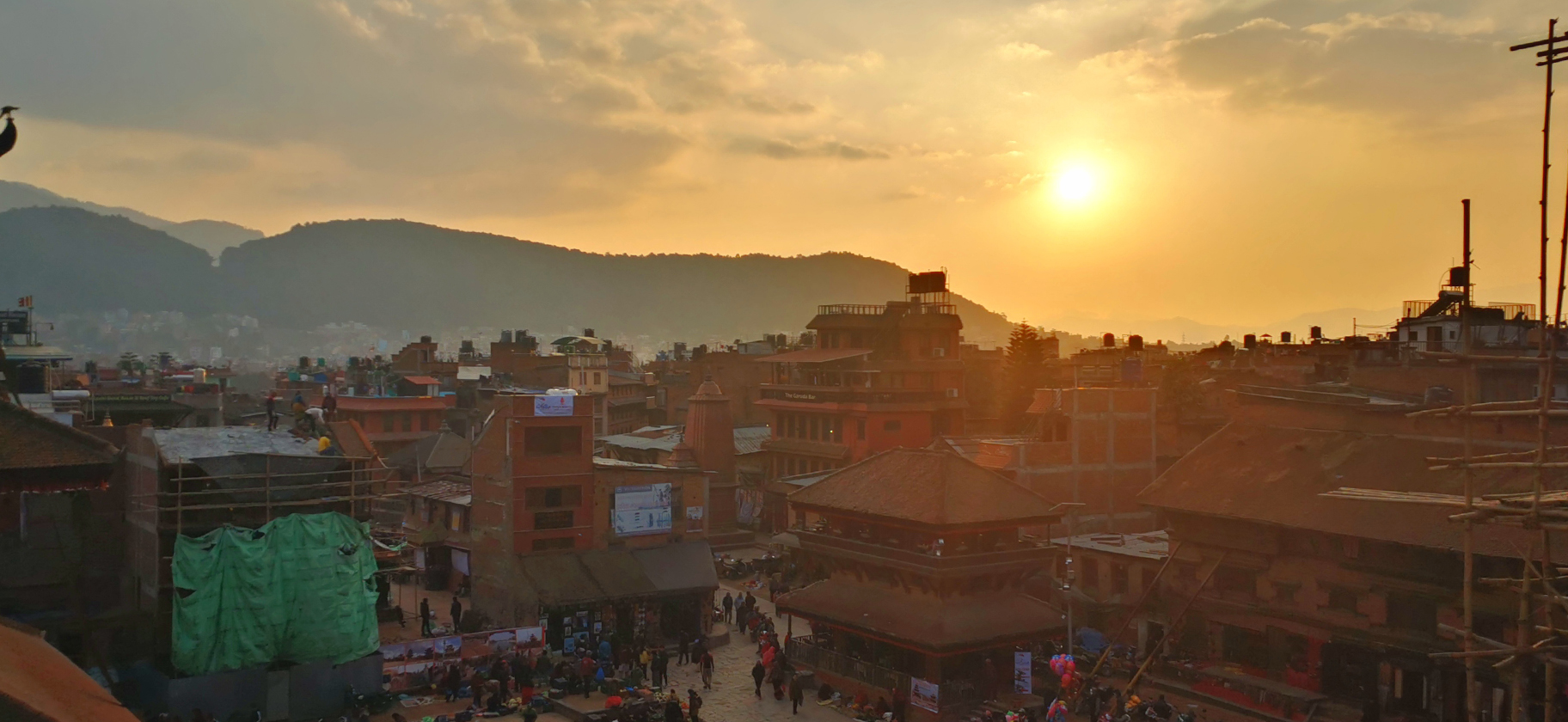
I think of myself as average height but I was a good six inches taller than everyone else on my flight from Muscat to Kathmandu. As we packed ourselves into the bus that would take us from the gate to the plane I could see the tops of so many heads – all of them men, all of them (were I betting man) Nepalese.
It was January in the northern hemisphere, but the cold and the damp that hit me when we landed in Kathmandu took me by surprise and chilled me to the bone. Muscat rests along the Tropic of Cancer and Kathmandu is less than 5 degrees of latitude further north, but their respective climates could not be more disparate from one another. Every inch of Oman was covered in sunshine all of the day with little to no humidity and with temperatures soaring comfortably into the high twenties even in the winter months. On the other hand, Nepal was cold and grey and neither the sun nor the mountains under which the city sits could be seen through the thick clouds that loom over it. The mercury was struggling to climb above 10 degrees serving as a telling reminder that it is not solely the distance from the poles that is the determining factor of the pleasantness of the climate of any one country, but that the topography and the people within it matter too.
Of the 230 or so countries that exist today, Nepal ranks in the low seventies when it comes to population density, with a population approaching 30 million within a set of borders that cover an area approaching 150,000 square kilometres. What this statistic does not make apparent is the fact that much of that area is covered by mountains with all of those 30 million people crammed together into the narrow streets of its few cities that are sandwiched tightly into the valleys that wind around the mountains. Kathmandu, the capital and most populous city in the country, is one of the most crowded and chaotic places I have ever laid eyes on. The city is fascinating but it is a disordered mass of so many people squeezed in elbow to elbow, all trying to get somewhere, all moving about honking horns, blaring their motors and kicking up dust and soot and every manner of pollution that it is no wonder that over the years the city has lost sight of the world’s tallest mountain range which is only a few kilometres away. The Kathmandu Valley from Lalitpur to Bhaktapur is a sprawling agglomeration of villages that have expanded their borders to form one megacity. These villages are linked together by several overcrowded highways that are all in a constant state of gridlock and getting anywhere can take all day.
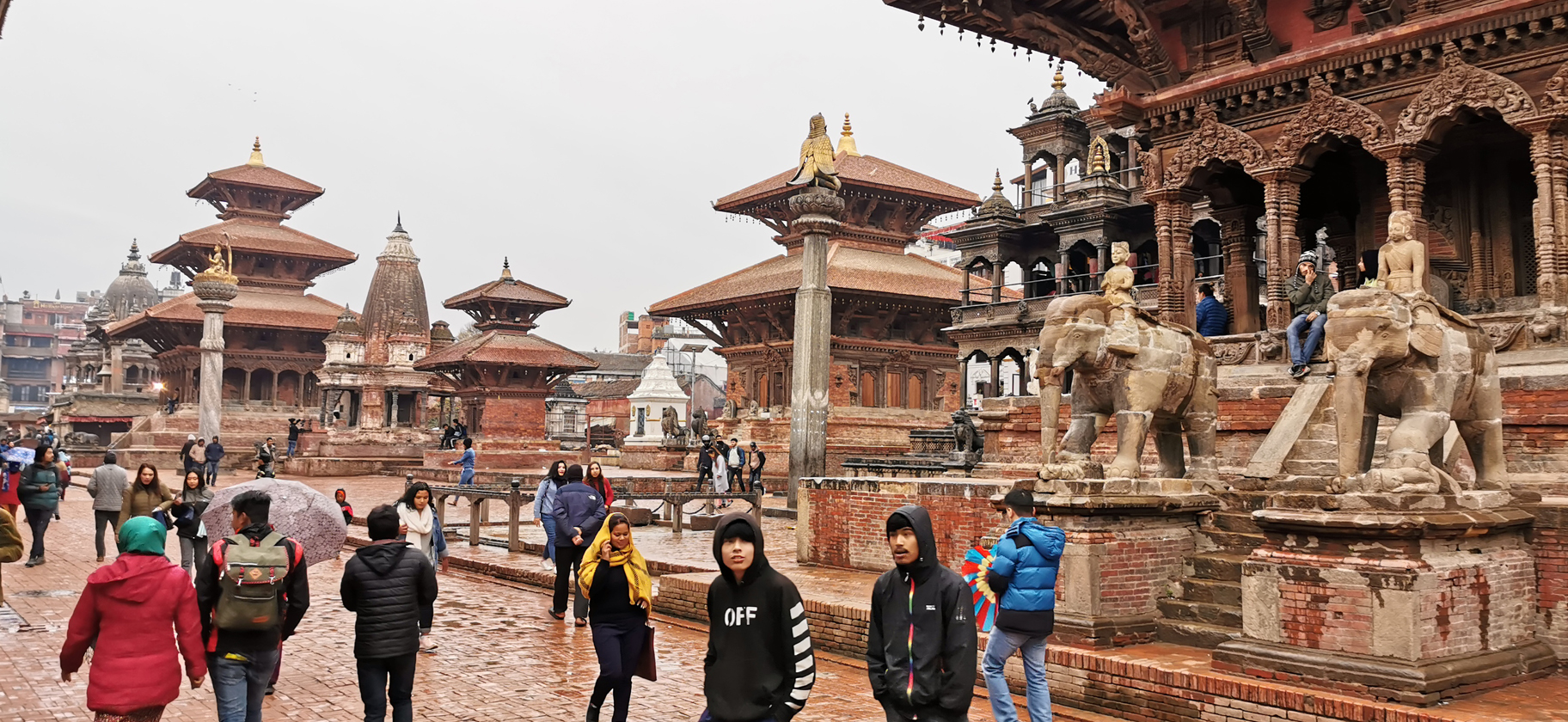 Durbar Square is a maze of palatial buildings and Hindu temples made of ruddy bricks with ornately carved wooden columns and tiled rooftops. All of the main squares in all of the villages in the valley are in various states of repair from the devastating earthquake that rocked the area in 2015. Fanning out from Durbar Square, the buildings hang over one another with hundreds of wires crisscrossing and dangling off the sides. Around every corner, there is a stupa, or a stepwell, or a temple, and visitors can not travel more than a hundred metres before happening upon something with some manner of religious significance. Within the villages, there are no lanes and there are no sidewalks, so everyone on foot or in a motor vehicle makes their way along any road at their own pace with little regard for their own, or others’, safety. You have to have your head on a swivel lest you get lost or run over, or run over because you are lost. Walking the streets around Patan, a village in the valley a few kilometres south of Kathmandu proper, I had that feeling again that everything I was seeing was the last thing I would have seen where I just was. Oman was so evenly spread out that it required a car to get anywhere or get anything you might be looking for.
Durbar Square is a maze of palatial buildings and Hindu temples made of ruddy bricks with ornately carved wooden columns and tiled rooftops. All of the main squares in all of the villages in the valley are in various states of repair from the devastating earthquake that rocked the area in 2015. Fanning out from Durbar Square, the buildings hang over one another with hundreds of wires crisscrossing and dangling off the sides. Around every corner, there is a stupa, or a stepwell, or a temple, and visitors can not travel more than a hundred metres before happening upon something with some manner of religious significance. Within the villages, there are no lanes and there are no sidewalks, so everyone on foot or in a motor vehicle makes their way along any road at their own pace with little regard for their own, or others’, safety. You have to have your head on a swivel lest you get lost or run over, or run over because you are lost. Walking the streets around Patan, a village in the valley a few kilometres south of Kathmandu proper, I had that feeling again that everything I was seeing was the last thing I would have seen where I just was. Oman was so evenly spread out that it required a car to get anywhere or get anything you might be looking for. 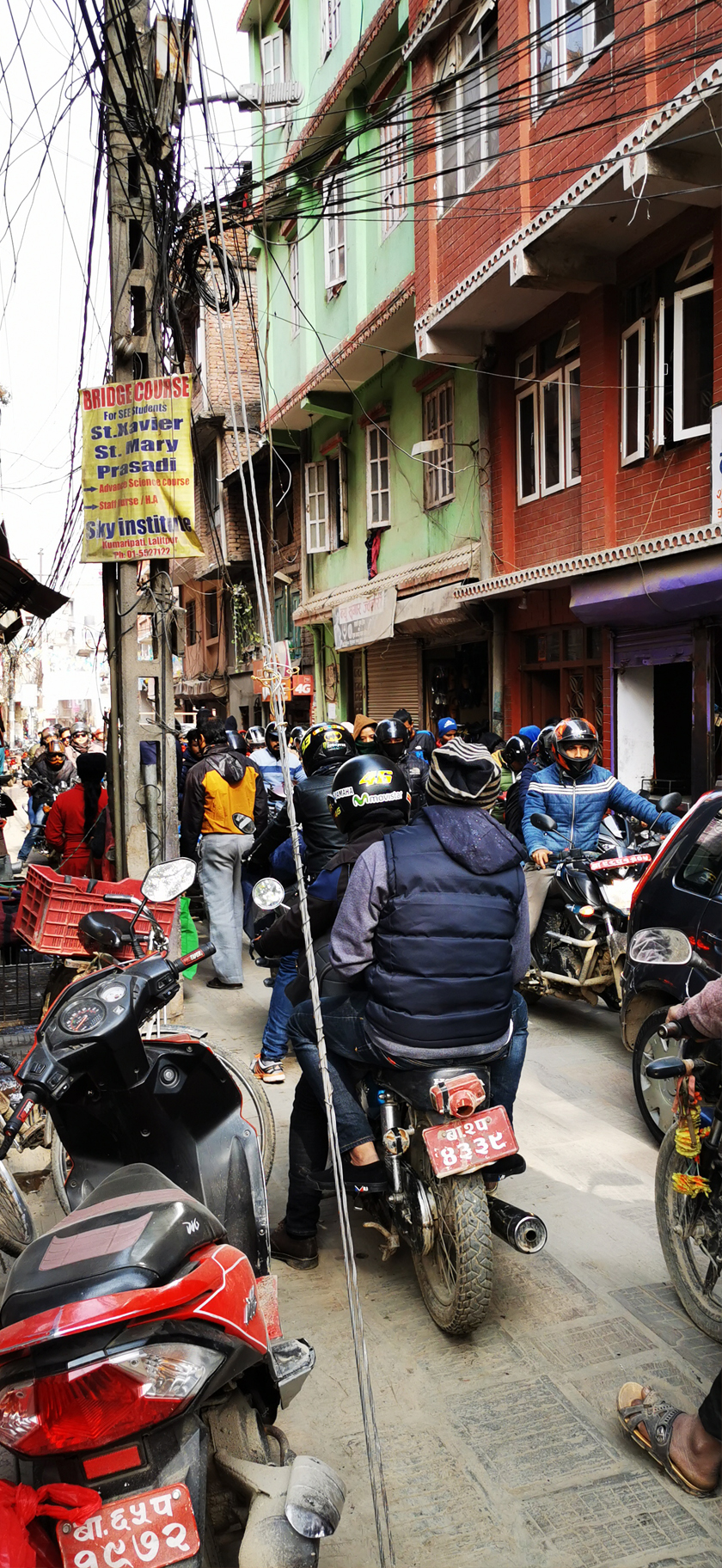 In Kathmandu, you can be spun around by a convoy of motorcycles speeding down a street no wider than your outstretched arms, fall down backassward in the mud, and come up right in front of an entire series of shops that will all sell you exactly what you are looking for.
In Kathmandu, you can be spun around by a convoy of motorcycles speeding down a street no wider than your outstretched arms, fall down backassward in the mud, and come up right in front of an entire series of shops that will all sell you exactly what you are looking for.
My accommodation is located down a dark street of broken cobbles in an old brick building with a large and heavy wooden door and beautifully carved window frames. Rajit lives in the home with his family on the top floor. He leads me up a steep winding wooden staircase to my room and offers me some spiced milk tea to help me get settled. I take off my shoes and step onto the cold stone floor of the bathroom and wash my face. I am tired from the day of travel and relieved to be somewhere safe. It is a small room, but I don’t require much and the bed that is resting on the floor is outfitted with a heated blanket. All of my clothes are designed for summer weather so I crawl inside as I sip my spiced milk tea to try and warm up. It is too early to get too comfortable so once I finish my tea I lock up my room using the dungeon master’s key and heavy bolt, wave to Rajit, and head back out into the streets to further explore my surroundings.
A group of women huddle around a fire burning in an old metal bucket seeking a few moments of warmth and comfort from the cold. 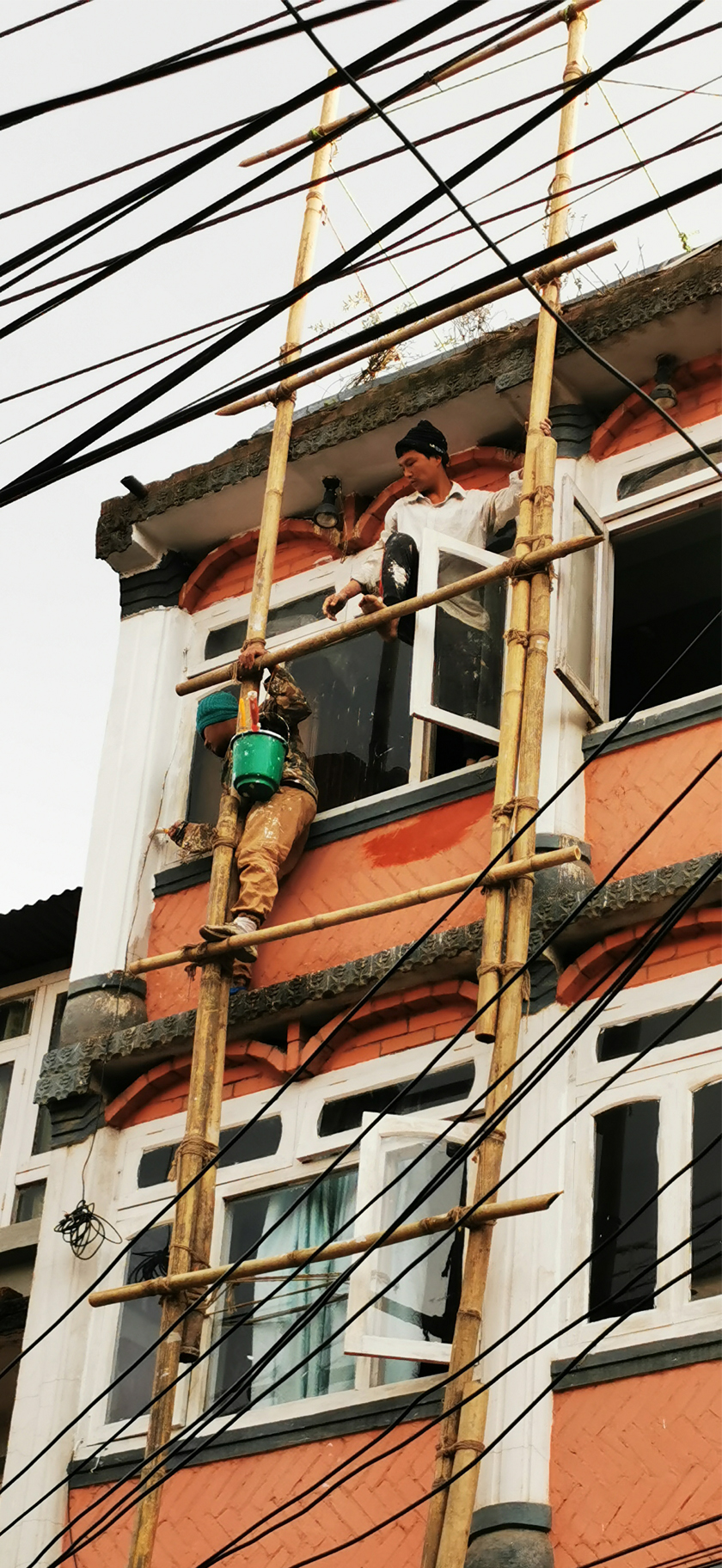 Some men have scaled the side of a building on a makeshift scaffolding where they hang perilously off the side reaching into inaccessible corners whitewashing the window frames. A man stands outside of his art studio where tourists are encouraged to buy spiritual knick-knacks sacred to the Hindu-Buddhist – wood carvings, brass statues, and colourful thangkas. Steam rises out of an aluminum pot where a man with a small cart has warmed a hearty helping of momo (meat-filled dumplings) which he is selling for a few rupees. A hippie ex-pat, and part-time guide, pulls the tap in a local pub serving up Carlsberg to a fresh batch of tourists in brand new Columbia and North Face gear as they prepare to trek up to Everest basecamp over the next few days.
Some men have scaled the side of a building on a makeshift scaffolding where they hang perilously off the side reaching into inaccessible corners whitewashing the window frames. A man stands outside of his art studio where tourists are encouraged to buy spiritual knick-knacks sacred to the Hindu-Buddhist – wood carvings, brass statues, and colourful thangkas. Steam rises out of an aluminum pot where a man with a small cart has warmed a hearty helping of momo (meat-filled dumplings) which he is selling for a few rupees. A hippie ex-pat, and part-time guide, pulls the tap in a local pub serving up Carlsberg to a fresh batch of tourists in brand new Columbia and North Face gear as they prepare to trek up to Everest basecamp over the next few days.
There is a man tending to the chickens he has for sale in their bamboo pens. A woman inspects his inventory and makes her selection. He grabs the chicken and with a deft flick of his wrist sets off a spasm of flapping wings and flailing feet as feathers fly off in all directions. It only lasts a few seconds before the chicken’s body goes limp. He asks the woman a question and she nods. Grabbing his cleaver he places the chicken on a wooden stump covered in guts and entrails and with one swift stroke hacks off its head and drains the blood into the nearby sewer. He gives the open wound a wipe with a filthy rag before placing the chicken into a used plastic bag and handing it over to the woman in exchange for a few notes.
I head off in search of the faint sound of the constant tapping of metal on metal that I can make out in the distance. I pass some homes built into the ground with the doors open and families preparing their evening meal. I walk down the wrong street and am met by a barking dog keen to protect this small sector of the city that it has laid claim to while its owners scream at it to shut up and let me pass. The sound of the tapping begins to grow louder. I find its source when I peer into a garage where a troupe of young men are furiously chiselling the ornamentation into a countless number of bronze Buddhas that will eventually be sold at the nearby shops.
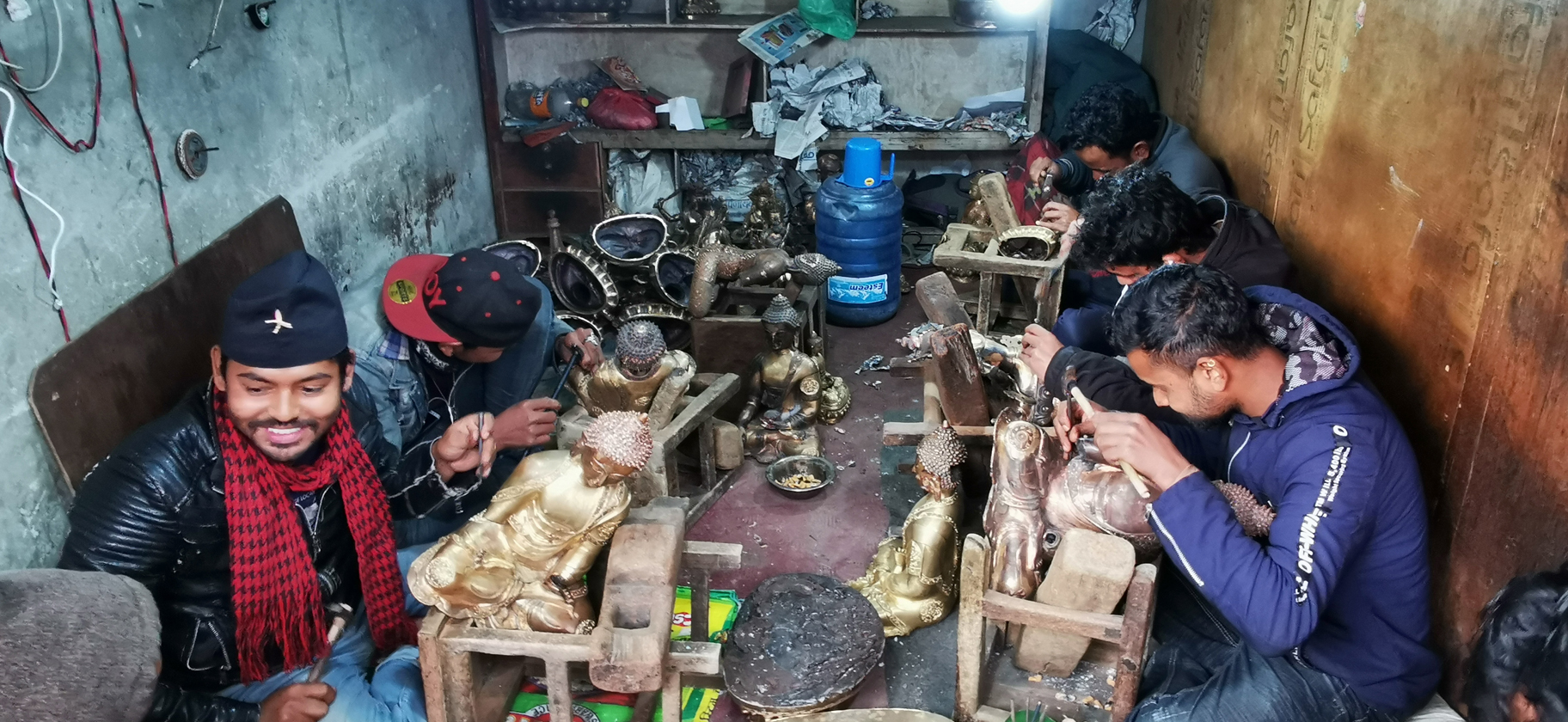
The smell of spices emanates from a doorway and I follow my nose into a small eatery. There is one long picnic table on one side and an array of bowls filled with prepared dishes on the other. A woman stands behind the food looking at me waiting to see what I will ask for. 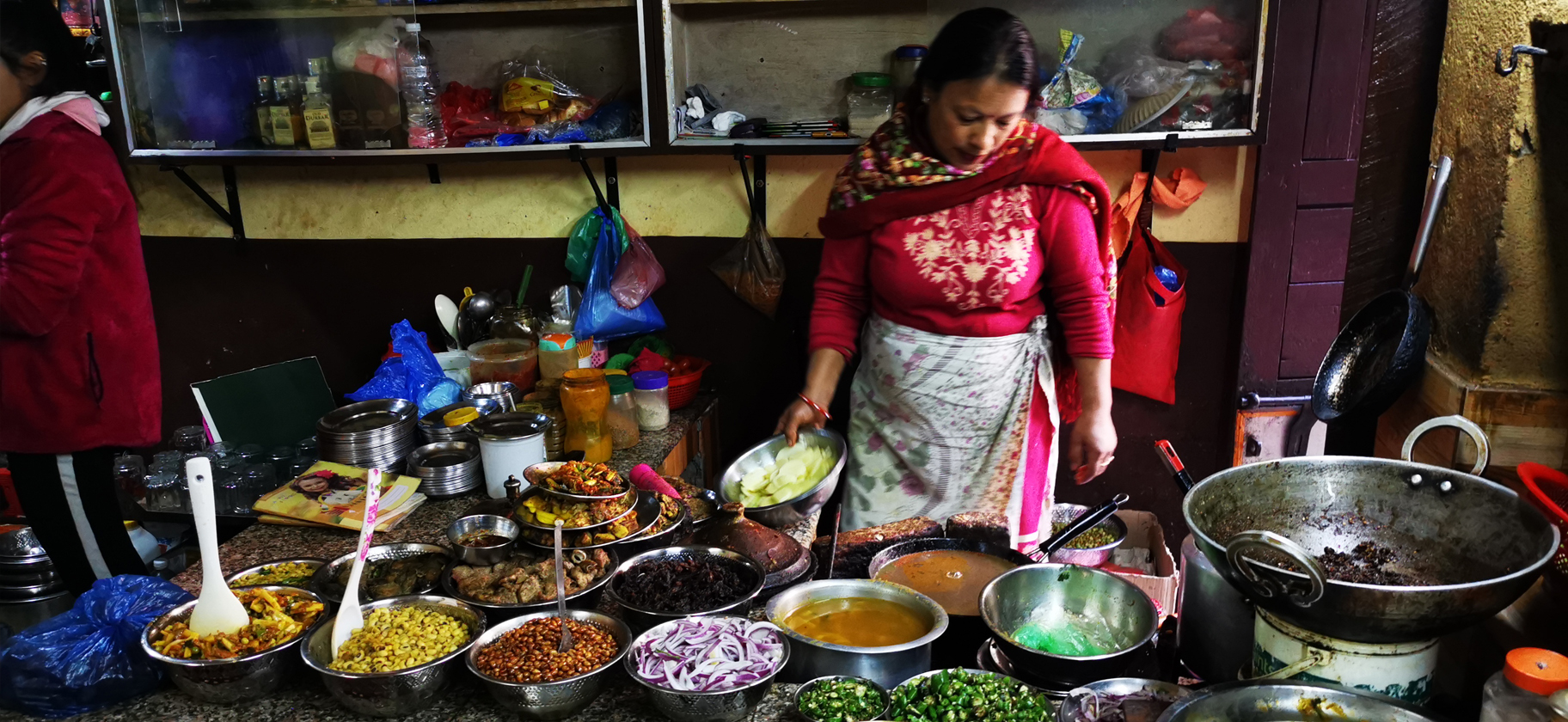 I try to explain that I am just looking but they keep pointing me in various directions either upstairs or inviting me to sit. I know I will have to eat eventually but I can’t rightly account for what it is that is actually in front of me – this is an adventure for day two or day three, but not within the first few hours of arriving in this strange land – I need to get my bearings and have a better grip on where I am.
I try to explain that I am just looking but they keep pointing me in various directions either upstairs or inviting me to sit. I know I will have to eat eventually but I can’t rightly account for what it is that is actually in front of me – this is an adventure for day two or day three, but not within the first few hours of arriving in this strange land – I need to get my bearings and have a better grip on where I am.
Nighttime descends on the city and a few street lamps flicker with a faint light while others simply don’t have the strength. Several shops and businesses remain open but in darkness not wanting to use up any excess electricity. A family of four sit in the doorway of their home that is built into the basement of an old brick building as the father adjusts the placement of embers that spark some bits of cardboard and a few slabs of particle board from some old furniture. The purr of running motors keeps a steady rhythm as motorcyclists weave delicately in and out of the cramped streets and alleys and with a degree of caution now that the sun has gone.
A monk clad in orange robes emerges from the darkness and notices me. He approaches with purpose holding a small golden dish in his hand filled with a red clay powder with which he hopes to lay a blessing upon my forehead in exchange for a donation. A pusher notices me and grimly whispers “hashish!” under his breath though there is little effort made to be subtle. He looks the part as if buying drugs from the smarmiest character in Kathmandu is a selling point.
I creep off the street into a brightly lit Chinese restaurant and ask if they do takeaway. I haven’t worked out the conversion from dollars to rupees so the prices on the menu are of little help to me. Chicken chow mein seems like a safe bet – likely to fill me up and unlikely to poison me or set me too far back financially. I buy a bottle of Nepal Ice beer and a bag of chips to complete the meal and tote it all back up to my room.
I crawl back into bed and under the thermal blanket. Though the flight lasted only four hours I am exhausted. But it is not because of the time zone difference, instead, it is the cultural difference that has worn me out. I tear into my chow mein – my only meal for the day. I flip open my laptop and watch youtube videos as I sip my beer. The noise of the city begins to go silent and the only sound that I can hear is the sound of raindrops dripping off the side of the buildings onto the stones and into the puddles along the street below.